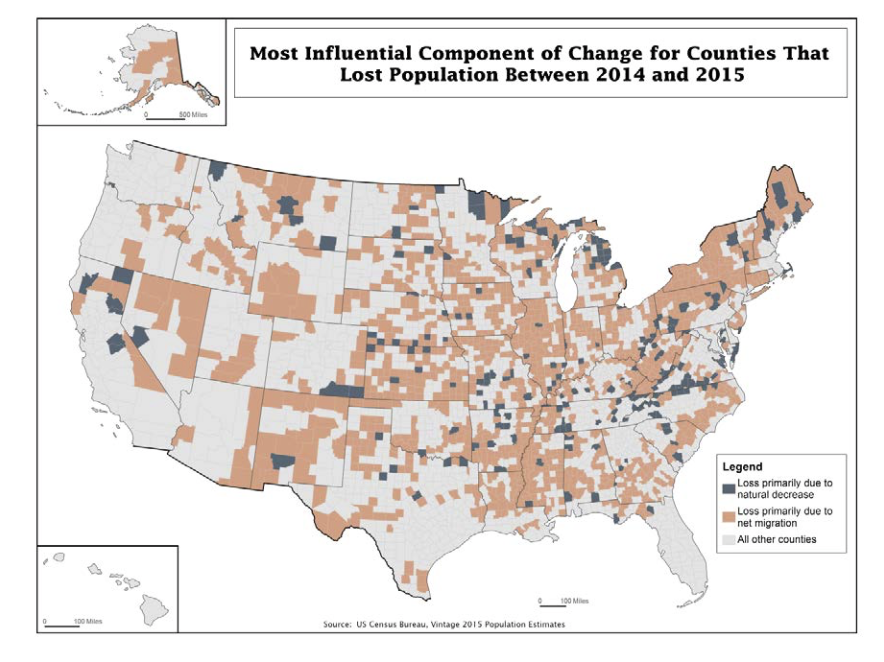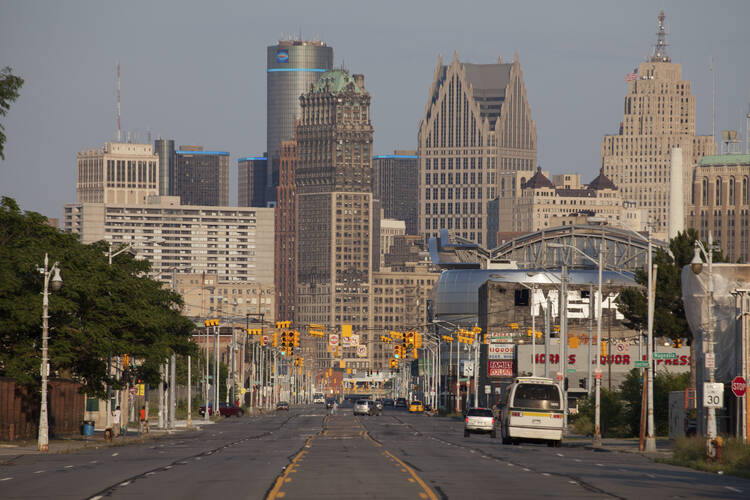A little more than half the counties in the United States—1,653 out of 3,142—lost population between the 2010 Census and 2015, according to estimates released last week by the Census Bureau. The country as a whole grew by about 4 percent over this period, with generally higher rates in suburban areas and in the South and West, though some older urban areas like New York and Boston are growing thanks to large immigrant populations. The half of America that’s losing people, and has never quite recovered from last decade’s recession, is the one confounding political experts.
The “loser” counties have supported different candidates in the presidential primaries held so far, with Donald J. Trump doing well in the South and Appalachia, Bernie Sanders in New England and the upper Midwest, Ted Cruz in the Great Plains and Rocky Mountain states, and Hillary Clinton in majority-black and Hispanic counties, including Detroit's Wayne County. The one thing almost all of them have in common is negligible support for the “establishment” Republicans (i.e., Marco Rubio and John Kasich), who have run best in relatively prosperous areas with population growth and growing immigrant populations, such as northern Virginia and Columbus, Ohio. In the Iowa caucuses, for example, Mr. Rubio won Dallas and Johnson, the only two counties that have grown by at least 10 percent, but his weak showings in population-loss areas left him in third place statewide. (In the Republican primaries, Mr. Trump has shown a pattern of doing better the farther he gets from a state’s population center and from its capital.)
Mr. Rubio and Mr. Kasich, along with Jeb Bush, started with what now passes as positive campaigns; their message was, “Yes, Barack Obama has ruined America and Hillary Clinton would ruin it further, but America can bounce back with a few quick fixes.” They apparently did not find receptive audiences in places with more deaths than births (which is the case in 1,135 counties), and with far more people moving out than in. And there are a lot of such places. According to the Census Bureau’s map of population change from just 2014 to 2015, Delaware and Hawaii are the only states without any population-loss counties. Connecticut has only one county that gained people at all from 2014 to 2015 (Fairfield, on the commuter rail out of New York City); upstate New York and downstate Illinois suffered losses in every county, and “loser” counties cover almost all the land area in states from Maine to Mississippi. (In the map below, light-shaded areas lost population mostly due to people moving out; dark-shaded counties lost population mostly due to deaths outnumbering births.)

Mr. Trump generally has done well in population-loss counties, but he hasn’t thrived in the 194 counties that would have lost population from 2010 to 2015 if not for immigrants—and thus may see them as an economic benefit. Among the biggest in this category is Miami-Dade, Florida, which lost a net 82,566 people to other places in the United States but gained a net 211,162 from international immigration. Miami-Dade was the only county that supported Mr. Rubio in the Florida GOP primary, and his path to the Republican nomination would have involved getting the lion’s share of delegates from other counties in this category, including Queens, New York; Philadelphia, Pennsylvania; and Hudson (Jersey City), New Jersey. Some of Mr. Trump’s most tepid support so far has been in places outside the Deep South that fall in this category. In Chicago’s Cook County, he got 8.7 percent of the combined Democratic and Republican vote; in Ingham County (Lansing), Michigan, he got 12.1 percent; in the city of Norfolk, Virginia, 13.1 percent.
In contrast, Mr. Trump has done well in counties where newcomers from elsewhere in the United States far outnumber immigrants. Maricopa County (Phoenix) gained 148,432 people from internal migration and 52,571 people from immigration, and Mr. Trump got 27.2 percent of the combined Democratic and Republican vote there. He got more than a third of the total vote in Lee County (Fort Myers) and Charlotte County (Punta Gorda), Florida, and in Horry County (Myrtle Beach), South Carolina, whose population booms are largely fueled by people moving away from counties where the foreign-born make up an increasingly large share of the population.
Trump thrives in “left behind” counties
Writing on “The Geography of Trumpism” the New York Times’ Neil Irwin and Josh Katz note that Mr. Trump has performed best in places where Census respondents claim “American” ancestry (as opposed to “English,” “German,” “Irish,” etc.). His supporters, they write, “have largely missed the generation-long transition of the United States away from manufacturing and into a diverse, information-driven economy deeply intertwined with the rest of the world.”
They quote William Frey, a demographer at the Brookings Institution: “They’re not people who have moved around a lot, and things have been changing away from them, but they live in areas that feel stagnant in a lot of ways.”
So far, Mr. Trump had achieved his highest share of the combined Democratic and Republican vote (55.4 percent) in Glascock County, Georgia. About 120 miles southeast of Atlanta and home to about 3,000 people (90 percent white), it is a “dying” county, according to Census estimates, with 200 deaths to only 151 births over the first part of this decade and almost no one moving in. Glascock is notable for a lack of four-year-degree holders (only 11 percent of adults over 25) and for a median household income ($40,089) well below the state and national average. But its poverty rate of 19 percent and unemployment rate of 5.8 percent are close to the state average. The highest poverty and unemployment rates in Georgia are in mostly black counties like Clay and Hancock (both of them also “dying”), and Mr. Trump was far less popular in these places.
Winston County, Alabama, a few miles northwest of Birmingham and Mr. Trump’s second best county, tells a similar story. It is almost all white, has few college graduates and has incomes below the state average, and it is dying—1,615 deaths to 1,284 births over the past half-decade and a few hundred people moving out. But it is not among Alabama’s worst places for poverty or unemployment; again, those would be majority-black counties that have turned out for Ms. Clinton. Exactly 40 years ago, Glascock and Winston counties were on the same side as the majority-black counties that lagged economically, voting for Democrat Jimmy Carter, but that biracial coalition fell apart just four years later, when the white counties shifted toward Ronald Reagan.
Mr. Trump’s appeal is not limited to economically distressed areas. The biggest county so far where he has gotten more than 40 percent of the combined Democratic and Republican vote is Baldwin County, Alabama, which includes the suburbs to the east of Mobile. The college-degree rate is 29 percent and the median household income is $50,183, both well above the state average. It is a fast-growing county, but almost all of its newcomers are from elsewhere in the United States rather than from abroad. Its main similarity with Glascock and Winston counties is that it is almost all white. Baldwin County bucked the rest of Alabama in voting for “establishment” candidates John McCain and Mitt Romney in the 2008 and 2012 Republican primaries; it’s one of the places where Mr. Rubio should have done well if he had a chance at the nomination, but where Mr. Trump got more than twice as many votes.








